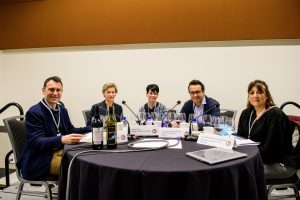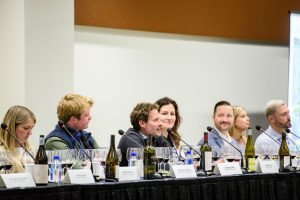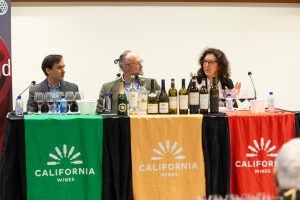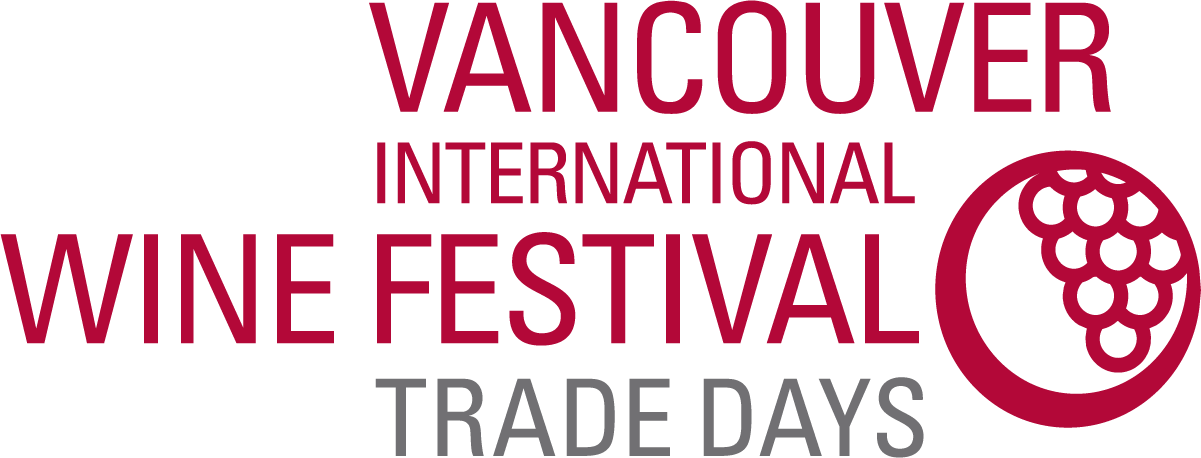Does BC Have a Wine Identity?
Wednesday, April 26, 10-11:45 a.m.
Recap by Jennifer Matli, Wine Acumen
Host: Katarina Vucic
Moderator: Dr. Jacques-Olivier Pesme
Panelists: Dr. Simone Castellarin, Charles Goemaere, Dr. Merje Kuus, Dr. Stéphanie Marchand-Marion
This seminar seemed like the setup for a joke, along the lines of what do you get when you bring together five professors, a lecturer, and six wines at 10 o’clock in the morning? The answer: a lovely discussion and warm champagne! Jokes aside, as it was a room full of wine enthusiasts, I wouldn’t be shocked to hear that some began discreetly sipping the Champagne the moment they were seated.
The topic under discussion was whether BC has a wine identity, and the professors walked us through the the potential definitions and associated implications around wine identities. For, as Dr. Stéphanie Marchand-Marion from Bordeaux shared, wine is unique in that we have no idea how it will taste before opening the bottle – and that once it is opened, it changes.
Dr. Simone Castellarin shared that in developed regions, identity is known, and it takes time for this to be defined in newer regions. Starting with Champagne, Dr. Charles Goemaere shared with us the Charles Heidsieck Brut NV, Champagne. I enjoyed its nose of popcorn and limes followed by a soft mouthfeel and floral finish in this balanced sparkler as he reflected on the winemaking approach.
Dr. Merje Kuus stated that regional identity is a compilation of stories that connect with associations and collective memories and story lines rooted in what is already there. Which was interesting, as the next wine was the Willamette Valley Vineyards Bernau Block Pinot Noir 2019, from Oregon’s Willamette Valley. Its nose was full of raspberries, cranberries, strawberries, hints of cocoa and I noted that it “smells like home, nostalgia.” A sip transported me back to walking into their tasting room in McMinnville on date night five lifetimes years ago. I was blown away that one smell of this wine left me near tears – bringing back memories and dreams rooted in a particular time and place – which was triggered by sticking my nose in a glass of wine from a beloved wine region.
The next wine was the AdVini Chateau Patache d’Aux, Medoc 2017 from Bordeaux. It was a Merlot-based blend produced from a Cabernet Sauvignon based producer in a challenging year. Their winemaking philosophy is focused on structure, freshness and spiciness.
Next on the list was the Catena Zapata Adrianna Vineyard “Fortuna Terrae” Malbec 2019 from Mendoza. Although I waxed poetic in my notes, penning that this wine was “dark, like my soul, inky and luxurious” – the rose petals, lilies, and blackberries combined for a balanced, interesting, sexy wine. It brought me back to Mendoza in 2010, full of wine shops and coffee bars, wine tastings with sommeliers and winemakers, abundant parilla (BBQ) and alfajores (cookies), of trying 10s or 100s of bottles of wine, of building community, and the uncertainty and excitement I felt as an entrepreneur, sommelier, and new mom living in Argentina’s wine capital.
Then suddenly, I heard Dr. Merje Kuus mention “emotions” – snapping me back into the present. She noted that a wine identify has to do with the emotions it triggered in a person considering the wine, which felt very true.
When the next wine was introduced, the only wine from BC, cheers erupted from the audience. Not the standing ovation, chanting, or feet-stomping kind of cheer, but the polite-spontaneous joy that comes when running into an old friend. The Nk’Mip Cellars Mer’r’iym Red Blend 2019 is from BC’s largest wine growing region, the Okanagan Valley, and the winery was founded 20 years ago. This wine is a New World take on a Bordeaux-style blend, a deeply hued, decadent and bold red wine. The energy in the room suggested that this wine triggered positive memories and associations for this group of BC wine enthusiasts.
Identity is a concept that is in flux. In talking about BC, Dr. Jacques-Olivier Pesme shared that viticulture is expanding to the Northern parts of the value due to climate change and Dr. Charles Goemaere shared that in Champagne they’re now harvesting 18 days earlier than 30 years ago and that the average yield has been reduced by 20% due to climate change. Likewise, Dr. Stéphanie Marchand-Marion shared that in Bordeaux, the wine in bottles is not the same today as 20 years ago and that the influence of critics, climate changes, and changes in consumer preferences all contribute to this. As a result, Dr. Jacques-Olivier Pesme indicated, there is a debate in Bordeaux around potentially introducing new varietals.
We finished up the tasting with a visit to Portugal’s Duoro Valley with Graham’s Quinta dos Malvedos Vintage Port 2012, which was from the driest year in the region since 1967 – and the reminder from Dr. Stéphanie Marchand-Marion that as we link emotion with wine, everyone becomes an ambassador.
We had tasted our way across multiple wine regions and styles, leaving us to process the emotions this triggered and to continue reflecting on wine identify implications for BC. As Dr. Simone Castellarin succinctly put it, in BC we still have lots to learn.
Certified Sommelier & Business Advisor
Wine Acumen
Instagram: @wine.acumen
Linkedin: @jenmatli

Keynote Speakers Lunch with Evan Goldstein MS
Wednesday, April 26, 11:45 a.m.-1:30 p.m.
Recap by Sid Cross
Evan Goldstein MS returned for his third time at the 44th Vancouver International Wine Festival and delivered a scintillating talk on Terroir – A Sense of Place.
Evan is a fountain of wine knowledge with my first delightful exposure to him way back in October 1988 as Sommelier at the iconic Square One (there with his mother the talented Chef Joyce Goldstein) in San Francisco at a Chateau Lafite vertical dinner where he brilliantly served all the older wines including Chateau Lafite Blanc 1960 and 1959.
What a wealth of experience he has! He opened his address this time by modestly stating “I sound better when you are socially lubricated with wine!” He called “terroir” a unifying theory of fine wine but is it true or just a marketing myth? There are some indications like eucalyptus in Napa Cabernet, garrigue in Provence and fresh crisp textures from wine grapes grown in granite and limestone soils. We know wines can show differently across vintages and from parts of the same vineyard. Even blends (Champagne) can still show inherent terroir. Evan astutely asks rhetorically the question of how much is evolving terroir (affected by climate change) and how much is really style? The influence of winemaker’s fermenters of oak, concrete, and stainless steel plus brett, reduction and many other technical factors contribute to each wine’s showing. Compares wine style to an interpretive musical score or the cover of a popular song. Not all great wines have terroir.
Lots to think about but no definitive answer was given by Evan – except the wise “try to make the best wine possible from the places they come from.”
Twitter: @winefoodguru
Blog: blog.iwfs.org/

Defining the Root of BC Terroir
Wednesday, April 26, 1:30-3:15 p.m.
Recap by Joanna DiGeso, Somm Wine
Moderators: Christina Hartigan and Maude Renaud-Brisson
Panelists: Jim Faulkner, Ex-Nihilo Vineyards; Lynzee Schatz, Time Family of Wines; Chris Turyk, Unsworth Winery; Michael Kullmann, Osoyoos Larose Estate Winery; Graham Nordin, CedarCreek; Sandy Leier, Laughing Stock Vineyards; Charlie Baessler, Corcelettes Winery; Amber Pratt, Moraine Estate Winery; Richard Kanazawa, Bench 1775; Garron Elmes, Lake Breeze Vineyards
The Effects of Climate Change on BC Terroir
Defining the Root of BC Terroir brought together some of the best British Columbian wine producers to explore the essence of BC terroir at the Vancouver International Wine Festival.
Yet, we witnessed an undeniable sombre note to the panelists as they candidly discussed the challenges brought about by climate change.
While we can celebrate the region’s extended summer days and natural acidity, the short seasons and extreme temperature variations pose significant challenges for all producers going forward.
Heat Dome of 2021
The unprecedented “heat dome” in June 2021 exemplified this. It brought weeks of record-breaking high temperatures that were previously unheard of. Amber Pratt from Moraine Winery expressed her exasperation, saying, “I mean, really, who ever heard of a heat dome?”
During that event, Lytton experienced temperatures reaching 50 degrees Celsius, only for wildfires to burn it down the next day. Tragically, the heat dome led to the loss of 600 lives in our province. But while people can protect themselves with sunscreen or seek refuge indoors with air-conditioning, the impact on grapes is more severe.
How Grapes Handle Heat
How do grapes handle the heat?
“They shut down and don’t grow. It’s really bad with Cabernet Franc,” piped Lynzee Schatz from Time Family of Wines. “Now, we have a delayed spring this year. It was 4 or 5 degrees when we left (to come to Vancouver), and next week they’re calling for 20!”
Such extreme variability makes preparation particularly challenging to say the least.
Variable + Extreme
In complete juxtaposition, the 2020 vintage the year before gave an uncharacteristically cool and wet June. As a result, yields were down 20-30% in the Okanagan Valley.
Yet just north of the Okanagan in Lake Country, Jim Faulkner of Ex Nihilo experienced something entirely different. “We didn’t receive the drop in production that year like everyone else.”
In fact, his vines were so productive, he made the Pinot Noir we tasted without the characteristic pump over because the vats were simply too full!
Water Issues of the Near Future
Perhaps fittingly, it was the South African transplant who nailed the problem of climate change on its head. Garron Elmes from Lake Breeze winery added, “We’ve been so fortunate with the amount of water we have and no one is paying attention to this now. In 20-30 years we will not have enough water.”
And it’s true. Currently, the way many BC growers handle heat waves is by watering the vineyard to cool it off, both before and after the heat. It’s a colossal waste of our resources.
Trial New Grape Varieties
So, what do we do?
One possibility is to explore new grape varieties for cultivation.
On this note, Amber Pratt, who grows Syrah in Naramata worries that she’ll see a day when they can’t grow it anymore. More to this point, Richard Kanazawa from Bench 1775 was sure we could grow the Spanish grape Monastrell. Let’s just say, he didn’t achieve the results he was hoping for. Monastrell requires a long season for ripening and we just don’t have that.
Finding the best grape varieties for the future will take time.
Apply Better Viticultural Practices
Michael Kullmann, winemaker at Osoyoos Larose Estate Winery, offered some valuable insights. He proposed focusing on vineyard management, including selecting better rootstocks and implementing cover crops. “I mean, we haven’t even touched the surface of what we can do in the vineyard!”
Most importantly, Kullmann emphasized the need for changes in irrigation practices. “Despite irrigating before and after the heat dome, we still experience damage.” Napa Valley had to adapt its irrigation methods and has since seen improvements in wine quality. According to Kullmann, they now utilize misters in the vineyard.
Misting helps reduce the moisture disparity between the air and the roots. It not only prevents vine shutdown but also promotes water conservation giving mother nature a big hug along the way.
Certainly, Graham Nordin from CedarCreek Estate Winery concurred. Having transitioned to fully certified organic practices years ago, CedarCreek is witnessing enhanced ripeness levels while simultaneously achieving lower sugar levels in their grapes.
Planting in New Areas
Another solution to accepting the limits placed on us by climate change is to look at planting in other areas. On this note, Kanazawa expressed his belief that Vancouver Island could potentially produce the finest wines in the future.
This statement sparked a response from Chris Turyk of Unsworth, the sole winery representing Vancouver Island, who confidently remarked, “Hey, we already have the best wines!”
Summary
Whether it’s trialling new grape varieties, adapting cutting-edge irrigation techniques, or discovering better rootstocks, BC wine growers have their hands full mitigating the weather extremes brought on by climate change.
Still, BC producers are doing more than just a few things right to result in the wonderful flavours we sipped that day! So, let’s raise a glass to the blood, sweat and tears behind this glorious juice.
On that note, you can check out the tasting notes of the wines that day by clicking here.
Facebook: @sommwine.ca
Instagram: @sommwine.online
Twitter: @sommwine
sommwine.com

Southern Exposure
Thursday, April 27, 9:30-11:30 a.m.
Recap by Joanna DiGeso, Somm Wine
Moderator: Evan Goldstein MS
Panelists: Aurelia Montes Jr, Chief Winemaker at Montes Wines (Chile); Salome Hopkins Export Manager for Viña Ventisquero (Chile), Laura Catena, Managing Director of Bodega Catena Zapata (Argentina), Martin Kaiser, Deputy Director of Viticulture and Enology for Doña Paula (Argentina), Rafael Boscaini, Export Manager for Miolo Group (Brazil), Francisco Roig, Winery Principal and Winemaker of Vinhos 1750 (Bolivia), Marcos Carrau, Production Manager at Bodega Carrau (Uruguay).
South America Hosts This Year’s Vancouver Wine Festival
This year’s Vancouver Wine Festival showcased the best of South America, bringing together renowned winemakers and industry experts from Argentina, Chile, Uruguay, Brazil, and Bolivia. As Master Sommelier Evan Goldstein announced, this event brought together the “Big Guns” from across the continent. As attendees, we were all eager to taste wines from these diverse countries and explore the theme that unites them all.
So, what does unite them all?
Football + South America
Perhaps it’s football.
Certainly, that would be Dr. Laura Catena’s answer. Catena, a fourth-generation winemaker from Catena Zapata in Argentina proudly proclaimed to everyone, “I just want to let you all know that this year, Argentina is the World Cup Football Champion!”
It was a playful poke at the entire panel. But perhaps mostly directed towards Rafael Boscaini, Export Analyst from Miolo Wine Group in Brazil.
Of course, Brazil is known as being a FIFA boss having won five World Cup titles, the most of any team in the world!
But that’s not the only thing to watch out for with Brazil!
Look out for Brazilian Wines!
Moderator Evan Goldstein MS, highlighted Brazil’s Merlot wines as a must-try, along with the abundance of fresh-squeezed grape juice found at wineries.
Furthermore, Goldstein pronounced, “All those French varieties that didn’t do well in Europe because of phylloxera – they are killin’ it in Brazil! Think Alicante Bouchet, Marselan, and Petit Manseng.”
Uruguay’s Fight of the Underdog
Yet it was Bodega Carrau from Uruguay who shared their gold speckled Petit Manseng at the trade event.
Goldstein explained that, “Mr. Carrau (who is the 12th generation winemaker from Bodega Carrau) figured out how to do geo referencing for grapes at 1/10th the cost and then he gave that to the world!” Geo referencing allows us to view the different geographical layers of a vineyard.
Let’s get back to football! Did you know that Uruguay’s national team is nicknamed Los Charrúas, after the indigenous peoples of the area. They are said to operate under “Garra Charrúa” or the “fight of the underdog” having taken home four recognized FIFA titles with a mere 2.3 million inhabitants.
Chile’s Panache for Trade Agreements
And poor little Chile with a much larger population of 20 million hasn’t even won a single World Cup title. Are they perhaps compensating a little with their wines that constantly deliver way above their price point?
According to Goldstein. If there’s one thing Chileans have brought to South America is their panache for “…cutting trade agreements everywhere they go”. In fact, they’ve negotiated no less than 31 trade agreements, ensuring their spot as the “Top Dawg” wine exporter they are today!
Aurelia Montes Jr., the Chief Winemaker of Montes Wines and a custodian of his family’s legacy, exuded an air of quiet confidence as he sat tall and grinned calmly throughout the Vancouver tasting event. Or, was it a subtle smirk, one of absolute confidence in his unwavering belief in the quality of the wine he presented that day?
He did bring the “Alpha M”.
Our other host from Chile, Export Manager of Viña Ventisquero, Salome Hopkins, shared a wine blend of two grapes Chile does well: Syrah, and Carmenere. Carmenere is a transplant from Bordeaux and if you thought that it always shows notes of green pepper, you’d better try their Vertic from Apalto.
“Don’t overlook Pais and the return from random grape varieties in South America,” boomed Goldstein.
Bolivia Surprises!
And then there’s Bolivia! Bolivia has only qualified for the World Cup once. Oh wait! We’re talking about wine here…
Was Bolivia on anyone’s radar when it comes to wine??
In his book on South American wines, Christopher Fielden stated in 2010 that winemakers of other Latin American countries felt Bolivia had the best wine grapes in the world. It simply lacked experience and equipment.
Well, things change…
And Francisco Roig, Partner and Founder of Vinhos 1750, has achieved precisely that. A native Bolivian, he immigrated to the United States and fell in love with a French woman, an oenophile by blood. Hence, we savoured the most surprising wine of the day.
In fact, Bolivia may now have the highest vineyards in the world. Or is it Argentina?
Who knows.
Argentina + High Altitudes
But the attendees of Southern Exposure got to taste not one, but two wines from the foothills of the extinct volcano Tupungato that day. One from Catena Zapata and the other from Doña Paula presented by Martin Kaiser, the Deputy Director of Viticulture and Enology. It’s no small matter that Tim Aitken MW named him “Viticulturalist of the Year” in 2020
Big guns, indeed!
So, what is the one theme that unites all of these countries? Is it football or wine, or is it something else.
We’d say it’s family.
Check out the outstanding pours from that day here.
Facebook: @sommwine.ca
Instagram: @sommwine.online
Twitter: @sommwine
sommwine.com

California Wines: An Era in the Making
Friday, April 28, 9:30-11:30 a.m.
Recap by John Schreiner, John Schreiner on Wine
California’s outsized influence in the wine world
Presenter: Elaine Chukan Brown
Panelists: Mark de Vere MW, Robert Mondavi Winery and Nicolas Paris MW, E & J Gallo Winery
With more than 4,000 wineries producing 87% of all the wine made in the United States, the California wine industry is an economic powerhouse with outsized global influence.
“If there is an issue in viticulture and winemaking to be solved, we have the resources to solve it,” California wine educator Elaine Chukan Brown told an audience at the 2023 Vancouver International Wine Festival. She was the moderator of a seminar and tasting of California wines.
California’s power comes both from the size of the wine industry and its technical prowess. There are wineries the length and breadth of California. The state alone ranks as the fourth largest wine producing region in the world by volume.
A report recently done for the Wine Institute and the California Association of Winegrape Growers found that the California wine and winegrape sector and allied businesses deliver a total economic contribution of US$73 billion annually to the state’s economy and US$170.5 billion annually to the U.S. economy.
If it were country, California would rank as the world’s fifth largest economy. More important is the nature of that economy: highly technologically advanced and open to new ideas. The winemaking and grape-growing research done by California’s universities is among the best in world, and is shared with the wine industry worldwide.
Currently, the issues being confronted by the California wine industry involve the environment and climate change. There has been a substantial commitment in recent decades to organic or sustainable viticulture. The objectives range from conserving water to conserving wildlife. A number of endangered birds and insects have rebounded with the significant reduction in the use of pesticides and herbicides.
The Monarch Tractor Company of Livermore, CA, is a recent example where technology and the wine industry intersect. The company’s electric tractors, which can operate as much as 15 hours on a battery charge, reduce a vineyard’s carbon emissions and generally improve the economics of grape growing. The Peter Michael Winery in Calistoga, which has been introducing electric farm equipment to its business since 2008, purchased a Monarch tractor in 2023, in part to further reduce the winery’s carbon foot print.
Because of the global size and influence of the California wine industry, such environmental innovations are spilling over to wine regions elsewhere.
Twitter: @goodgrog

A Tale of Two Terroirs
Friday, April 28, 9:30-11:15 a.m.
Recap by Joanna DiGeso, Somm Wine
Moderators: Christina Hartigan and Evan Goldstein MS
Panelists: Pablo Aranda, Bodega Argento; Cecilia Carrasco, Zuccardi; Laura Catena, Catena Zapata; Germán Di Césare, Bodega Trivento; Marie-Hélene Dumais, Bodega Piedra Negra; Salome Hopkins, Viña Ventisquero; Carol Anai Koch Gonzalez, Cono Sur Vineyards and Winery; Aurelio Montes, Jr., Montes Wines; Pablo Prieto, Viña Carmen
Soil + Cool Climates
A Tale of Two Terroirs seminar treated attendees to some remarkable flavours featuring the crème de la crème of Chilean and Argentinean wines.
Yet, as both Chile and Argentina boast vast landscapes, labeling each as a single terroir would be a gross oversimplification. Nevertheless, our group savoured wines that shared a captivating connection. Every single one of these extraordinary wines flourished on the nurturing embrace of rocks, chalk, granite, or clay. Moreover, they all hailed from a region graced with a cooler climate, either through lofty altitudes or refreshing ocean breezes.
For it is in these cooler climates that the most enchanting and aromatic wines are born. Some of the wines we sampled were cultivated at dizzying heights, like the slopes of the dormant volcano, Tupungato, or the prestigious Altamira GI in Argentina’s Uco Valley. Others basked in the gentle caress of oceanic winds, such as the Casablanca Valley in Chile.
High Altitudes and its Effect on Grapes
Our moderator, Master Sommelier Evan Goldstein, eloquently pointed out the impact of high-altitude plantations on terroir. “Planting at high altitudes really transfers terroir. The skins of the grapes get thicker and the grapes grow smaller from the increased UV exposure.” And as any wine enthusiast knows, it is in the skins of the grapes where the true essence and flavours of the wine reside.
Perfecting Terroir Takes Time
However, perfecting terroir requires time and dedication. Goldstein further emphasized, “Let’s not forget that when grapes were first planted in Chile and Argentina, vineyards were strategically located near ports because things travelled by horse and buggy.” Thankfully, modern-day growers have the freedom to plant their vines wherever terroir beckons.
In a hilarious revelation, Laura Catena from Catena Zapata shared her father Nicolas’ secret behind the discovery of the legendary Adrianna Vineyard, home to their renowned White Bones Chardonnay. Surprisingly, it was a stroke of sheer luck, as he humbly admitted.
But the Argentines are not content to rest on their laurels. Germán Di Césare from Trivento winery revealed their audacious plans of venturing into the extreme south of Patagonia for vineyard planting. They are pushing the boundaries, travelling even further south than the vineyards of New Zealand, marking a thrilling milestone for wine aficionados worldwide.
Carmenere’s New Terroir
One only needs to look at Chile and its success with the grape Carmenere to see the transformative power that time has on showcasing great terroir.
Carmenere, originally from Bordeaux, fell out of favour there because it needs constant warmth. Yet, the grape adores its new home in Chile.
But there was a time when Chilean Carmenere was mistakenly labeled as Merlot, causing confusion among wine professionals. Unlike Merlot, which ripens easily even in moderate climates, this particular Merlot from warmer Chile exhibited unripe green characteristics due to the misidentification.
However, as Evan Goldstein MS astutely pointed out, “Growers in Chile always knew the difference—they recognized there was Merlot and then there was Merlot Chileno (what we call Carmenere).”
Over time, Chileans have perfected their understanding of terroir, realizing that Carmenere thrives in specific soils and requires very late harvesting. They’ve also discovered the best blending partner for Carmenere is Petit Verdot. Furthermore, Chilean growers have developed superior strains through Massal Selection, a meticulous process of selecting exceptional plant cuttings for propagation.
New Frontiers, Better Grapes
That means Carmenere coming out of Chile no longer has those unripe green pepper notes.
In fact, these new strains are so successful, they’ve now travelled overseas to Ningxia, China replicating Chile’s success.
But that’s not the only grape to look out for from Chile!
Our moderator Christina Hartigan, enthusiastically recommends Cinsault as a rising star among Chilean varieties. Its distinctive character, expressive qualities and ability to translate terroir are sure to leave a lasting impression.
Better Pest Management
Growers not only require time to understand and adapt to their grapes’ needs, but they also need to develop effective strategies to protect their precious vineyards from predators. Pablo Aranda, Director of Exports for Bodega Argento, shared a remarkable and innovative approach employed by their organic winery to fend off their most persistent foe—the ants.
Without the use of pesticides, Argento strategically plants specific species of flowers in the vineyard. When the ants come into contact with these flowers, they return to their nests and alter the pH of the fungus within. Astonishingly, this gentle intervention prompts the ants to voluntarily depart from the vineyard, ensuring the vines remain undisturbed.
Brilliantly, Cono Sur Vineyards adopts a truly collaborative approach to pest management. They engage the children to catch the troublesome bugs. Additionally, they exhibit their commitment to sustainability by repurposing the leftover fermentation materials, turning them into valuable compost for future vineyard nourishment.
Summary
With each step forward, Argentine and Chilean producers continue to push boundaries, embrace innovation, and nurture their vineyards with unwavering passion. The world eagerly awaits the exceptional wines that will emerge from this tireless pursuit of excellence. Cheers to the future of these two terroirs!
You won’t want to miss the tasting notes from the wines tasted at A Tale of Two Terroirs.
Facebook: @sommwine.ca
Instagram: @sommwine.online
Twitter: @sommwine
sommwine.com

